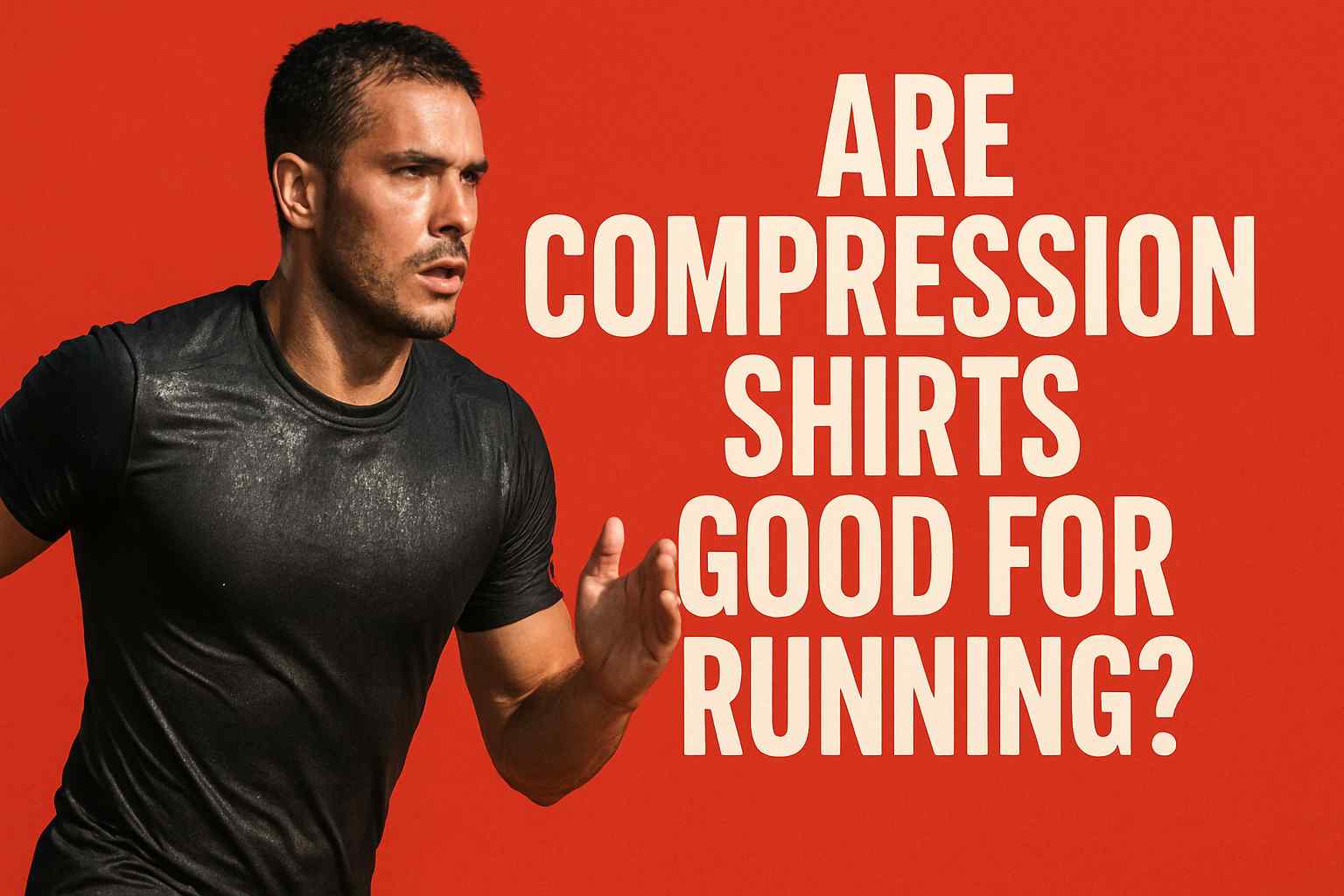Are compression shirts good for running? This question comes up often among fitness enthusiasts, especially those of us over 50. After testing dozens of options over thousands of miles in the DC metro area, I can give you a definitive answer: yes, compression shirts for running deliver significant benefits that make them worth every penny for runners of all ages, but especially for seniors.
Table of Contents
What Exactly Do Compression Shirts Do for Runners?
Compression running shirts aren’t just tight-fitting tops. They use graduated compression technology in running apparel to apply specific pressure patterns that boost circulation and support muscles.
Unlike regular running shirts, compression gear for runners hugs your upper body with calculated pressure – more at the extremities, less at your core. This science-backed design enhances blood flow back to your heart.
9 Research-Backed Benefits of Compression Shirts for Running
 Buy affordable compression training shirts!
Buy affordable compression training shirts!
1. Do Compression Shirts Actually Improve Running Performance?
Yes! Research published in the International Journal of Sports Physiology and Performance (2016) found that compression gear for improving running economy can enhance your aerobic threshold and VO2max slightly.
This means you can maintain faster paces with less effort.
For senior runners using compression clothing, these small gains make a significant difference in race times and training quality.
2. How Do Compression Shirts Help with Muscle Recovery?
Post-run recovery compression clothing works by increasing blood circulation to your muscles. This enhanced blood flow delivers more oxygen and nutrients while flushing out metabolic waste products like lactic acid.
A 2019 study in the Journal of Strength and Conditioning Research confirmed that compression garments for running recovery help muscles recover more quickly after intense exercise.
The result? Less soreness and faster recovery between training sessions – crucial for masters runners who typically need more recovery time.
3. Can Compression Shirts Reduce Muscle Vibration?
With every footstrike, your muscles vibrate. Over miles, these micro-vibrations contribute to fatigue and potential injury.
Compression gear for reducing running muscle soreness provides stability to your muscles, minimizing these vibrations.
Less vibration means less muscle fatigue and lower injury risk – especially important for those of us with more miles on our bodies.
4. How Do Compression Shirts Handle Sweat and Temperature?
Moisture-wicking compression shirts for hot weather running outperform standard running tops in managing sweat. The tight-fitting synthetic fabrics pull moisture away from your skin to the fabric’s surface where it can evaporate quickly.
This evaporative cooling creates a natural air conditioning effect during summer runs.
In winter, this same wicking action prevents the chilling effect of sweat against your skin when running with compression shirts in cold weather.
5. Do Compression Shirts Prevent Chafing?
Synthetic blends that prevent chafing while running are a game-changer for comfort on long runs. The seamless construction and second-skin fit of quality compression shirts eliminate the friction that causes painful chafing.
No more bloody nipples or irritated skin after those double-digit training runs with compression shirts for marathon training!
6. How Effective Are Compression Shirts for Sun Protection?
Many premium compression shirts now offer UPF sun protection for summer running with ratings of 30-50+.
This built-in sun barrier protects your skin during those long outdoor training sessions without the need to constantly reapply sunscreen.
For runners over 50, this added protection is increasingly important as skin becomes more vulnerable to sun damage with age when running outdoors with compression gear.
7. Can Compression Shirts Help with Running Posture?
Compression running tops for improved posture provide gentle support that encourages proper alignment. Many designs specifically target the upper back and shoulders, areas where runners commonly slouch as fatigue sets in.
Better posture means more efficient breathing and less strain on your back – critical for maintaining good form in the later miles of longer runs with compression shirts for endurance running.
8. Do Compression Shirts Work for Winter Running?
Compression shirt layering for cold weather runs creates an ideal base layer system. The tight fit traps a thin layer of warm air next to your skin while still wicking away moisture.
Long-sleeve thermal compression shirts for winter running with brushed interiors provide additional warmth without bulk, making them perfect under a light jacket or vest for winter training.
9. Are Compression Shirts Worth the Cost for Older Runners?
Recovery-focused compression gear for older runners offers exceptional value despite the higher price tag. While a quality compression shirt might cost $40-80, the extended recovery benefits can mean fewer missed training days and better performance over time.
For runners over 50 investing in their health and performance, the return on investment in compression shirts for senior athletes is substantial.
Top Features to Look for in Running Compression Shirts
The best compression shirts for running performance include:
- Graduated compression that’s tighter at the extremities, looser at the core
- Moisture-wicking fabrics that pull sweat away from your skin
- Antimicrobial treatments to prevent odor development
- Flat or welded seams that won’t chafe sensitive skin
- UPF sun protection (at least SPF 30) for outdoor training
- Ventilation panels in high-heat areas like underarms
- Support structures for improved posture and muscle stability
How to Choose the Right Compression Shirt for Your Running Needs
What Compression Level Works Best for Running?
For daily training, choose medium compression level for daily training runs – tight enough to support muscles without feeling restrictive.
Save higher compression levels for race day or particularly intense workouts when using compression shirts for race day performance.
Beginners should start with lighter compression and gradually work up to firmer options as they adapt to the feeling.
What Materials Provide the Best Performance?
Look for shirts with advanced moisture-wicking technology for compression running shirts that feature:
- Nylon/polyester/spandex blends (80-20-10% is common)
- Antimicrobial treatments to prevent odor
- Flat or welded seams to prevent chafing
- Mesh ventilation panels in high-heat areas
Premium brands use proprietary fabric technologies that enhance these properties – worth the extra cost for serious runners seeking high-quality compression shirts for running.
How Should a Compression Shirt Fit?
The proper compression shirt fit for optimal running benefits should feel snug everywhere without restricting breathing or movement.
You should be able to breathe deeply and move your arms freely in your properly sized compression running shirt.
Size charts vary significantly between brands, so always check measurements rather than assuming your usual size.
How I Use Compression Shirts in Virginia’s Variable Climate
Living near DC means training through humid summers and unpredictable winters. Here’s my personal compression shirt strategy for year-round running:
For summer: I rely on ventilated compression shirts for hot weather running with mesh panels during July and August humidity.
For spring/fall: Short-sleeve compression tops for mid-temperature running offer the perfect balance of support and cooling.
For winter: Thermal compression base layers for cold weather training under a light jacket keep me warm without overheating on the Capital Crescent Trail.
How to Maximize Benefits from Your Compression Shirts
When Should You Wear Compression Shirts?
For maximum benefit, wear your compression shirts for optimal running recovery:
- During runs longer than 30 minutes
- In the 2-3 hours immediately following tough workouts
- On recovery days to enhance blood flow to healing muscles
Compression recovery wear after marathon running is particularly effective in the 24-48 hours following a race or especially demanding training run.
How Do You Properly Care for Compression Shirts?
To maintain the compression properties and extend the life of your compression running gear:
- Wash in cold water with mild detergent
- Avoid fabric softeners (they clog the moisture-wicking fibers)
- Air dry or use low heat settings
- Replace when compression begins to fade (typically 6-12 months with regular use)
Real Results: What Difference Can You Expect?
As a 50+ runner, I’ve found three key differences since making compression gear for masters runners part of my regular rotation:
- My recovery between hard workouts has improved by about 20%
- Chafing issues have completely disappeared on long runs
- I feel noticeably less fatigue in my upper body during the later miles of marathons
While compression shirts for improved running won’t turn you into an elite athlete overnight, they provide incremental advantages that compound over time – especially valuable as we age.
The Bottom Line: Are Compression Shirts Worth It?
For runners over 50, compression shirts for better running performance deliver real benefits that justify their cost. The combination of improved circulation, reduced muscle fatigue, better thermoregulation, and enhanced recovery creates a performance advantage that becomes more valuable as we age.
If you’re serious about your running – whether you’re training for your first 10K or your twentieth marathon – adding 1-2 quality compression shirts for distance running to your gear rotation is a smart investment in your performance and comfort.
Start with one versatile option for your primary running conditions, then expand your collection based on your specific needs and preferences.
Ready to experience the difference compression can make in your running? Your muscles will thank you for it!
Frequently Asked Questions About Compression Shirts for Running
Are compression shirts good for beginners over 50?
Yes! Beginning runners over 50 often benefit most from the muscle support and reduced soreness that compression shirts for new runners provide.
How tight should a compression shirt feel?
It should feel snug but not restrictive. You should be able to breathe normally and move your arms freely in a properly fitted compression top for runners.
Can compression shirts help with arthritis pain while running?
While not designed specifically for arthritis, many runners report that the warmth and support from compression shirts for joint support help reduce joint discomfort during runs.
How many compression shirts do I need?
Start with one quality shirt. If you run more than 3 times weekly, consider investing in a second compression shirt for frequent runners to allow for washing between uses.
Are compression shirts only for slim runners?
Not at all! Compression shirts for runners of all sizes come in all sizes and provide benefits regardless of body type. Focus on proper fit rather than body size.
What brands make the best compression shirts for running?
Top brands for quality compression running shirts include Under Armour, 2XU, Nike, CW-X, and Skins. Each offers different compression levels and features to suit your specific needs.
Do compression shirts really work for older runners?
Yes, the benefits of compression shirts for senior runners are well-documented. Many runners over 50 report reduced muscle soreness, better recovery times, and improved comfort during long runs.

Rick Huey is a fitness writer who has dedicated his life to living an active lifestyle. With more than 30 years of experience in the fitness industry, Rick is a respected contributor for FitFab50.com, where he shares his wealth of knowledge with a wide audience. His dedication to promoting the benefits of living an active lifestyle has inspired many people to pursue their own fitness journeys with enthusiasm and dedication.
Last update on 2025-12-15 / Affiliate links / Images from Amazon Product Advertising API
